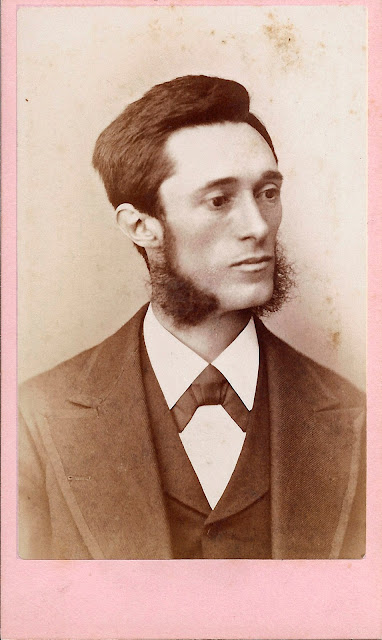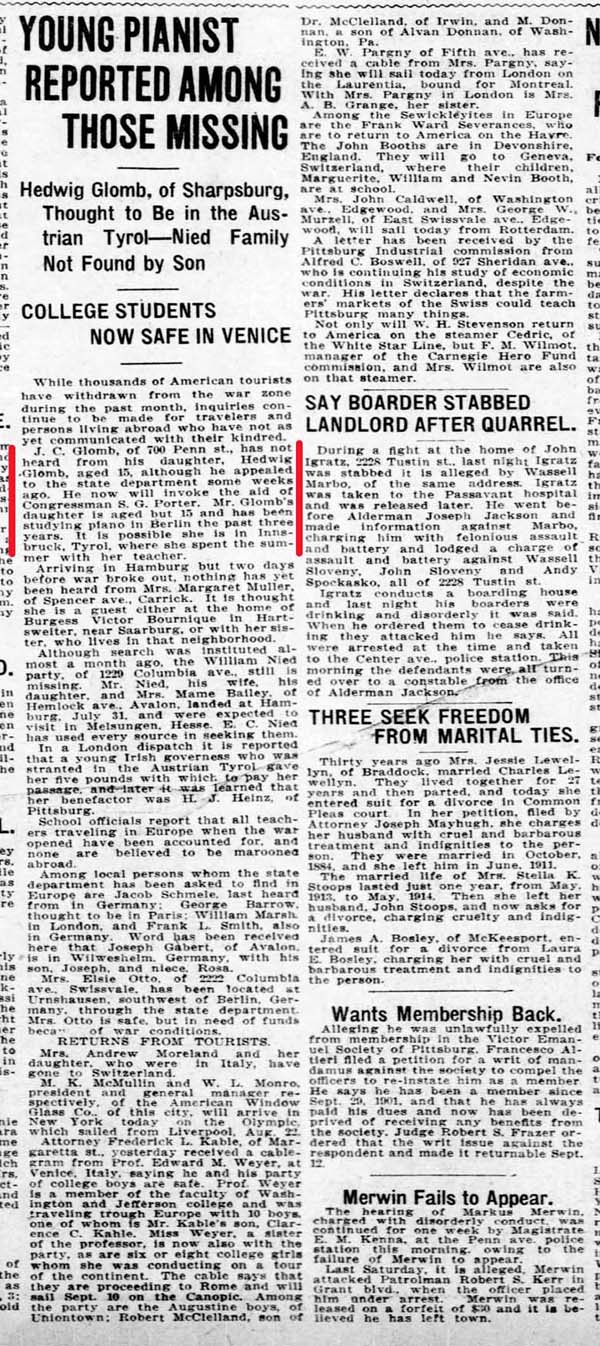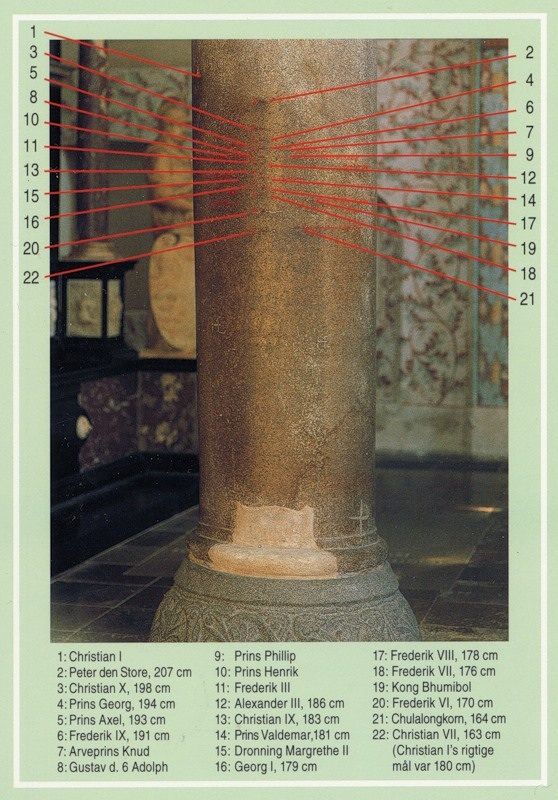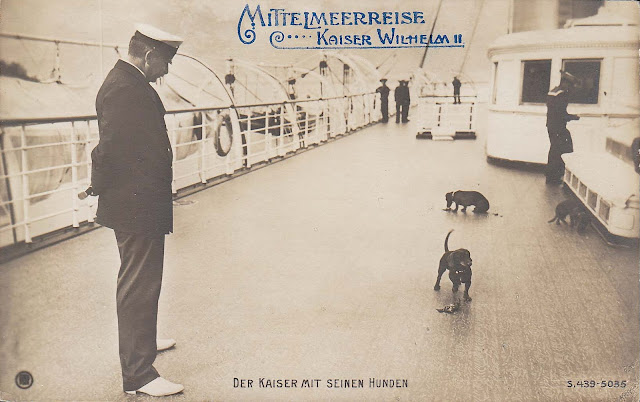It's all in the lips.
Whether it's the brilliance of a trumpet,
the brashness of a trombone,
the bluster of a tuba,
or the boldness of a horn,
the sound of a brass instrument
starts with a vibration in the lips.
It's a singular sensation that's unlike speaking,
as the musician blows a stream of air
through pursed lips pressed against a small metal cup.
The mouthpiece contains the resulting buzz
allowing the player to adjust
the air speed for tones high and low.
One note at a time
the basic technique
is not hard.
But blow two notes at once?
Impossible!
Unless you have lips
like this master musician.
He was
Capt. T. Jackellis
The King of Cornets.
Dressed in a formal white tie and tailcoat with medals pinned to the lapel, a man holds two cornets, one in each hand. They look identical, just standard B-flat cornets with three piston valves. His hair is carefully groomed. He sports a small Chaplinesque mustache. He is also a black man.
Across the photo is written:
Yours in Music
Capt. T. Jackellis
King of Cornets
Clearly a professional performer, this musician's promotional postcard had no date and no name other than his signature. It's a curious photo, obviously a vintage postcard from the early 20th century. What kind of surname is Jackellis? Why does he have two instruments? When did he play? And most peculiar, how did a black musician of an earlier era happen to have his photo postcard printed by
The Strand Studios, Piccadilly, Hanley?Hanley is in Staffordshire, England, southeast of Liverpool. It is one of six towns that in 1910 merged into what is now the city of Stoke-on-Trent. Since the Strand Studios' address uses only Hanley it suggests Capt. T. Jackellis's photo may have been produced prior to the city/county union. But if it dates to the 1910s, the heart of England seems an unlikely place to find a black cornet player.
Yet in February 1913, T. Jackellis was on the playbill for the Palace Theater in Dundee, Scotland. At 7 and 9 the public was encouraged not to miss
Kitty Stuart & Players, introducing T. Jackellis, the Greatest Double Cornet Soloist in the World. Also on the bill was
Flora MacDonald, the Scotch Lassie, Comedienne and Dancer, in addition to the
usual programme of B.B. Pictures.
![]() |
Dundee, Scotland Evening Telegraph
19 February 1913 |
The Dundee Evening Telegraph offered a review of this show which mixed variety acts around their silent films. Kitty Stuart and her players did a musical comedy which included Jack Ellis,
a marvel cornetist, whose double cornet solo called forth unstinted applause. Evidently Capt. T. Jackellis possessed a very rare skill that let him play simultaneously two cornets at one time.
![]() |
Dundee, Scotland Evening Telegraph
18 February 1913 |
But Kitty Stuart was
quite the accomplished multi-instrumentalist too.
She could play both the cornet and piano at the same time.
Despite the greenish sepia color of the half-tone image, this young woman's sequined gown and plumed bonnet sparkle in the photographer's light. Seated at an upright piano, her right hand holds a cornet to her lips while her left hand is at the keyboard. She is a buxom beauty with, I suspect, red hair. A suitable color for any Scottish lassie.
Her postcard has a signature written across the image
nearly identical to the one written on Capt. T. Jackellis's.
Yours in
Music
Kittie Stuart
March 1914
Below is a printed caption:
Kittie Stuart the Original Lady
Playing Cornet and Piano at the same time.
P.A. 25 Gassiott Road, Tooting, London
The back of the postcard has a personal note:
In remembrance of a
pleasant week.
Your true Friends
KittieStuartPlayers
The postcard was printed by the Imperial Publishing Co. of Longton, Staffordshire, another of the towns that united to form Stoke-on-Trent. It was never posted but the signature date of March 1914 makes this an image from before the start of the Great War. To my eye the handwriting is the same on both postcards, though
Capt. and
King of Cornets appear to be added in darker ink.
Miss Stuart's portrait is a very conventional postcard for an
artiste of the European music hall circuit of the 1900s. Jackellis's photo is also not unlike those of countless vaudeville performers of this era with one notable exception. He is a musician of color. And needless to say, his association with Miss Stuart's Players in a Scottish theater begs a lot of questions.
This is a photo detective mystery I did not expect to solve as I've had these two cards for some time while I searched for another card that would definitively connect the two musicians, but alas I have yet to find it for sale. Nonetheless the story is too good not to make an exception to my rule of only posting images I own and therefor I include this next image which was taken from an online auction.
It's another postcard that shows T. Jackellis dressed in a white summer weight suit while again holding two cornets. On a side table are three more instruments, a soprano slide trombone/trumpet, an absurdly elongated trumpet, and a coach horn. Across the image is another signature in the same hand as the other cards:
Yours in Music
T. Jackellis
March 1914
At the bottom is a long caption.
T. Jackellis, King of Cornets
Challenges the World for £50 to £100
Played before Their Majesties
King George & Queen Mary, July 11th, 1914
The Gold Cornets used by T. Jackellis were made by J.W.
York & Sons, Grand Rapids, Mich. U.S.A.
With Kittie Stuart & Players
P.A. — 25 Gassiott Road, Tooting, London
![]() |
Falkirk Herald
15 July 1914 |
In the second week of July 1914, King George V and Queen Mary paid a royal visit to the Scottish town of Falkirk, about halfway between Glasgow and Edinburgh. It was a very big occasion for a very small place. The local newspapers ran full page reports that were dense with names and titles and details.
The afternoon was very warm and sultry for Scotland. One newspaper reporter ventured into the great crowd of loyal subjects that lined the streets awaiting the arrival of their Majesties' motorcar.
On the outside sill of a window in the High Street sat Mr. T. Jackellis, a coloured cornet expert, who was appearing in the Electric Theater. He was garbed in white, and sported a sash of royal purple. He helped considerably to beguile the heavy-hanging time for the waiting people by discoursing melodies of every description, including the ever-popular ragtime, on his cornet. When the royal car put in an appearance in High Street, Mr. Jackellis played "God Save the King," and subsequently "Rule Britannia," with variations and in harmony on two cornets at the same time. * * *
The Falkirk Herald did not report whether King George and Queen Mary were amused or abused, but for a music hall artist this busking event was close enough to be a Royal Command Performance. The King was probably distracted because two weeks later on July 28th, Britain, along with the rest of Europe became engulfed in a terrible storm of war. It would not end until over four years later.
Certainly a talented musician like T. Jackellis
would know "God Save the King" by heart.
Except that he knew it
by a different title –
"My Country 'Tis of Thee."
Because Capt. T. Jackellis
was not a British subject.
He was an American citizen.
And his name was not T. Jackellis.
It was Ellis Thompson Jackson.
Just a bit over a year later in August 1915, Capt. Jackellis wore his purple sash for another photo. This one he took to the United States consulate in Birmingham to apply for an extension to his passport. Again he holds a cornet in each hand. His mustache now has a more politically incorrect Prussian curl.
The application was dated August 6, 1915. Ellis Thompson Jackson solemnly swore that he was born in Oxford, New Jersey on the 5th day of May, 1869. He was 46 years old. His permanent address was
5 Green St., Morristown, New Jersey where his occupation was
music teacher. He left the United States on September 17, 1907 and was temporarily sojourning in Birmingham and working as a
Stage Music Artist. He intended to return to the U.S. in 2 years.
The second page of the application has a description. His age has 56 inexplicably typed onto the page. His height was 5 feet, 5 inches. He had a high forehead, brown eyes, and a broken nose. His mouth was large. Chin: regular. Hair: black. Face: oval. Complexion: colored.
At the bottom of the page
the photo of Ellis T. Jackson
was affixed and embossed with the official consular seal.
It takes real bravura to use a publicity photo like this on a government identity document. We have to wonder what the consul thought when he interviewed Ellis T. Jackson, aka Capt. T. Jackellis. Did he demonstrate his split lip skill? But for future researchers, one could not ask for a better identification.
I should explain that this document was found at Ancestry.com based on other clues I discovered online. Various comments and questions that people left behind on the internet while searching for Capt. Jackellis's genealogy roots enabled me to piece together a fantastic story of how an African-American musician from New Jersey became a British music hall performer.
It required talent, courage, and hard work. Lots of hard work.
In 1900, Ellis T. Jackson with his wife Annie E. Jackson lived at 26 Water Street in Morris Township, Morris County, New Jersey. Ellis was age 31, born May 1869 in New Jersey. His occupation was
musician. His wife Annie was 28. They had been married 10 years and had two children, a son, Ellis T. Jr. age 8, and a daughter Lillian G. age 10. A brother, Harvey Jackson, age 23 lived with them too. He was a
laborer.It was not uncommon for a black man in 1900 to find employment as a musician. It was a skilled trade that could pay well. But it was never regular. Ellis listed 0 months employment while his brother had 6 months as a laborer.
It was the American age of segregation. Races did not mix except under strict rules, some decreed by law, others by custom. An African-American musician in 1900 would not expect to work on stage with white musicians. But he still might find work in show business. Performing in a popular entertainment that oddly was derived from African-American traditions. It was called the
Minstrel Show.
Beginning in the decades before the Civil War, before the end of slavery in America, traveling theatrical groups developed a variation on the classic musical comedy. White entertainers wearing blackface makeup and dressed in gaudy costumes performed a burlesque show with songs, dances and jokes that lampooned black people and denigrated slave and freedman alike. It was vulgar. It was tawdry and unsophisticated. It was racist in the extreme. Yet it was also immensely popular and produced a formula theatrical show that lasted for over 100 years.
After the war ended in 1865, it didn't take long for genuine Negros to recognize an opportunity. Many minstrel shows began adding African-American bands for parades or as a sideshow to the main show. Some white producers presented minstrel shows with all black performers ironically imitating the imitation by wearing blackface makeup too. In the 21st century it's very difficult to understand how bigotry and racism could be so successful but 19th century sensibilities on nationality, religion, ethnicity, gender, and race were very different and today's modern showbiz culture has deep roots in the old minstrelsy traditions.
Ellis T. Jackson was one of these black musicians who performed in minstrel shows, and he was good enough to be a band leader. His name appears with several minstrel shows in the 1890s. He toured the country from Oregon to Kentucky to Kansas to Michigan. But his home was Morristown, NJ where he and his wife raised a family. And where he taught them music.
In August 1897, the Nashville Tennessean rand a short article on
A Juvenile Prodigy from Morristown, a boy not 5 years old –
Ellis T. Jackson Jr. He was a gifted child who could play several musical instruments. He demonstrated the cornet by playing above the staff. He blew another brass horn down to low
G. He danced. He sang. He could plucked the mandolin with great skill as well as a banjo, violin, and guitar too. Even more impressive, when his father played a melody, the boy wrote out the tune in musical notation on a chalk board.
His father, Ellis T. Jackson Sr., was also teaching him to box. With his older sister, Lizzie.
![]() |
Nashville, TN Tennessean
22 August 1897 |
By February 1904, the Jackson family was no longer in New Jersey. Their new home was in Pawtucket, Rhode Island where little Ellis T. Jackson Jr. got his picture in the local newspaper.
![]() |
Pawtucket RI Times
17 February 1904 |
He stands wearing a white cap and uniform as he holds a trombone. At his side is a cornet on a case. The article headline reads
E. T. Jackson, Jr., A Boy Prodigy.
Only 8 Years Old But Can Play
Remarkably Well on Many
Musical Instruments,
Sing and Dance.
___
7,000 ONCE HEARD HIM
___
President McKinley and
Former President Cleveland Delighted
by His Instrumental Work.
![]() |
Pawtucket RI Times
17 February 1904 |
It seems accuracy on ages was only approximate in the Jackson family. In February 1906, another photo of Ellis Jr. appeared in the
New York Age, an influential weekly black newspaper with a national readership. The grainy image shows him in a military style band uniform and holding a trombone. The photo was attached to a report about the two juvenile bands that
Prof. Ellis T. Jackson, Sr. was leading, one for boys and a second for girls. The two ensembles had already given several concerts in Providence as well as Pawtucket.
![]() |
New York City New York Age
22 February 1906 |
The Jacksons were a very musical family where everyone played several instruments. Ellis Sr. also lead a proper band of adult musicians who found seasonal employment at seaside resorts or on excursion cruise ships in the Rhode Island region. In 1906 he was honored by a gift from his band of an ebony baton with silver mounts. He seemed to have achieved a rare high level of success for an African American musician. But it was not enough.
In September 1907 he took passage from Boston to Liverpool, England. On the S.S. Bruce ship manifest he is listed with a group of about twelve
Theatrical people. On the UK immigration record Mrs. Jackson and daughter Lillian are not listed, instead he is accompanied with just one companion, his son, Ellis T. Jackson Jr.. On the manifest the father's age was 38 on the immigration document only 36. The son's age was written as 11 but he was really 15 years old.
Eight years later Ellis Thompson Jackson needed someone in England to vouch for him, to affirm to a United States Consul that they knew him by that name. That person was Ellis Thompson Jackson Jr. who swore that he had known the above-named individual personally
All my life. On the application Ellis Jr. wrote his address as 245 Rosendale Rd, London, S.E.
So why did Ellis T. Jackson change his name? It was for the same reason many entertainers need a unique stage name. He didn't want to be mistaken for someone else.
In the decade before the war, a vocal group from Jamaica made several successful tours of Britain. Originally called the Kingston Choral Union and later the Jamaica Choir, its music proved very popular with British audiences. The choir's founder and director was a African-Jamaican named
Thomas Ellis Jackson, (1861-?) and usually written as
T. Ellis Jackson in programs and newspaper reports. So in order to prevent confusion with another black entertainer, Ellis T. Jackson, the greatest double cornetist in the world, needed a different moniker. So he became
Capt.T. Jackellis. How or why he chose the honorific
Capt. is still a mystery.
The Jacksons, father and son worked together on the British music hall circuit. At some time before 1913 they joined up with Kittie Stuart and Players. That act lasted until at least 1916. Beginning in 1917, Capt. T. Jackellis, was part of new group –
The Brazilian Trio. He continued to promote his double cornet skill and the trio's hook was evidently more instruments than players, as other members were also multi-instrumentalists. I don't have proof but it's possible that Kittie Stuart was part of this musical triangle but under a different name, as one report described a cornet/piano number played by one musician.
![]() |
Shields Daily News
23 July 1918 |
In 1918, American forces joined the allies on the battlefields of France. Ellis Sr. was too old to serve, but his son, Ellis Jr. was 27 and still a US citizen, so he had to register for a U.S. draft board. The archives of Ancestry.com preserved his registration card which was filed in August 1918 with an American consul in Britain. His address was the 245 Rosendale Rd. in West Dulwich, London, the same as in his father's 1915 passport application. His occupation was
Music Hall Artist employed by
Ellis Thompson Jackson. Ellis Jr. asked for an exemption on
Domestic Grounds as he was married with 5 children.
Finally in 1918 the war ended and Europe and Britain could return to peaceful endeavors. As far as I could learn, neither Jackson, father or son, ever returned to the United States. Ellis Sr. continued his double cornet act and took on a management role acting as a theatrical agent booking shows around the British Isles. He played theaters in Ireland, Scotland, and Wales, as well as England. He likely made trips to the Continent too. It was Show Biz and it was work.
The trail of the name of Capt. Jackellis and his double cornets in Britain is nearly continuous from 1912 to 1938. As Ellis T. Jackson, his career started in the age of American minstrel farce. In Britain he evolved in a time of ragtime and silent films. He finished in the modern era of jazz, radio, and cinema with recorded sound.
British theatres retained the tradition of variety acts for a long time, perhaps because its theatre circuit covered a smaller country with better rail connections. In October 1938, Capt. Jackellis was on the bill at The Alhambra theatre in Plymouth. The headline was Dr. Walford Bodie who combined ventriloquism with an
original electric chair from Sing Sing.
The musical act included
Capt. Jackellis performing
a treble-tongued polka on two cornets simultaneously, an accomplishment all the more remarkable since he will soon be celebrating his 80th birthday. He was actually only 69 years old.
![]() |
Plymouth, England Western Morning News
04 October 1938 |
* * *
Music is an art that requires dedication to be successful. For a brass musician, maintaining the lips over a lifetime is incredibly difficult. It demands constant practice to keep the facial muscles in concert shape. For a musician whose specialty was playing two cornets at once, the effort must have required extraordinary stamina to perform two or three shows a day for years on end. The technique of vibrating the lips at both corners of the mouth is understandable, and the symmetry of the two cornets' valves makes it possible to imagine the fingering. But humans have only one tongue and how Capt. Jackellis managed the articulation on two brass instruments at one time is a true wonder.
What makes this man's story so interesting is that he accomplished something that was very rare for an African- American musician from the late 19th to early 20th centuries to do. Forced by the circumstances of America's apartheid racist culture, he struggled to be an artist in the U.S. But by moving to Britain he discovered an audience that had no strictures against performers of color. He was now at liberty to make his own music without the debasing styles of the blackface minstrel show.
This is not to say that Ellis T. Jackson did not find bigotry and discrimination in Britain. Hatred has no national boundaries, and likely as Capt. T. Jackellis, he experienced a lot of prejudice and unfair treatment in British society. But the British culture must have seemed more favorable for him to stay in England for so long.
If the year of his birth, 1869, is correct, and because it is recorded on several government documents we must assume that it is, then Ellis Thompson Jackson was a contemporary of the first great African-American cornetists. He was older than
W. C. Handy (1873-1958) the so-called father of the blues and a musician whose career in minstrel shows and early ragtime/jazz music parallels Jackson's life. He was older than
King Oliver (1881-1938), one of the first great cornetists and bandleaders to come out of the New Orleans's jazz scene, and who was a mentor to
Louis Armstrong (1901-1971). And Jackson was the same age as
Perry George Lowery (1869-1942), the celebrated cornetist and circus bandleader, and whose Wikipedia page sadly is only published in German.
What did Ellis T. Jackson bring to Britain? A novel American musical style? A talented son who found a life in England? Did his wife Annie ever come over from Pawtucket? Did he ever return to America? There are still many unanswered questions about this remarkable man's story that I hope one day to solve. According to an incomplete family tree of Ellis T. Jackson on Ancestry.com, he died.in 1948 in England.
He was only 79 years old.
Long live the King of Cornets.
This is my contribution to Sepia Saturday
where every weekend is swinging.

























































































































































































































